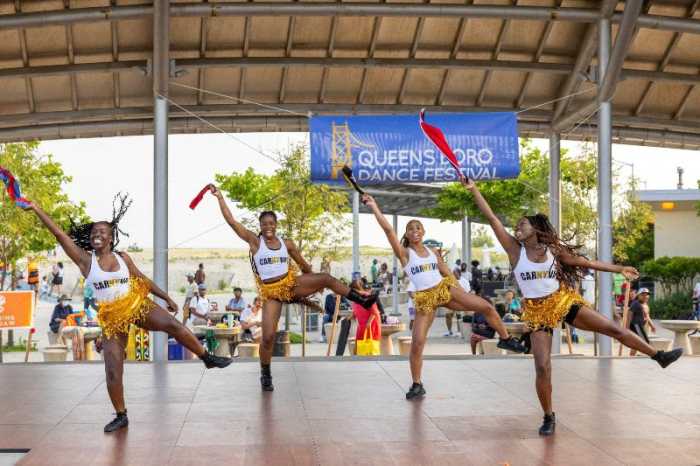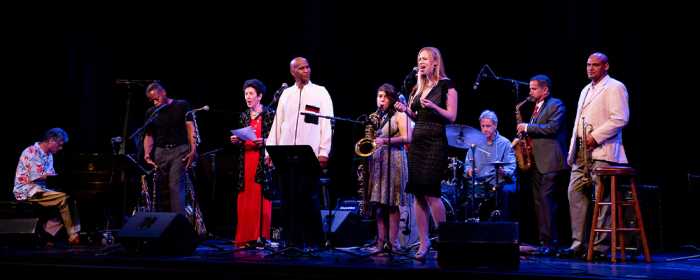By Kevin Zimmerman
Just like the words “eye,” “jam” and “mug” can each be either a noun or a verb, “scroll” is the latest member of the word club that straddles both categories.
Until quite recently, “scroll” simply described a roll of paper wrapped around a wooden handle, used as some of the earliest books—think Dead Sea Scrolls.
Today, people of a certain youngish age are probably unaware that the word could mean anything other than how a computer user fiddles with a mouse to move down a web page.
In her current exhibition, “Scrolling Confluence” at the Mid-Manhattan Library through May 26, Jackson Heights artist Carla Lobmier looks at both sides of the word—literally.
Lobmier has created two-sided, 13-feet tall, watercolor and graphite works on vellum paper to hang in each of the six windows facing Fifth Avenue and East 40th Street in the library’s Corner Room space.
“It is double-sided so it can be engaging outside and inside,” Lobmier said. “This way [viewers] can experience art unexpectedly.”
In the panels, each of which can be examined as a distinct piece, Lobmier has created a history of books and art through the evolution of scrolls.
Each painting represents a different place and time that helped move art and language forward.
“It’s a history of scrolls through art history,” Lobmier said. “Which is then a history of art making or the progression of the creation of art.”
Lobmier starts with India, where scrolls made their first appearance.
She also has an affinity for Indian art, so she figured that was the best place to begin. Other panels examine specific places (such as Egypt or Japan) or times (like the medieval era or Renaissance) that played a part in the history of scrolls, running up to the present world of technology.
The Indian panel’s interior side is dominated by a large figure dressed in traditional garb and jewelry. The scene is populated with lotus flowers and other vegetation. Vibrant reds, blues and greens fill the entire panel.
A man in a small sailboat gently floats across a body of water at the larger figure’s feet. Boats and water play prominent roles in the panels, because it is through trade and exploration that ideas were spread among cultures in past times, Lobmier said.
On the panel’s reverse—facing the sidewalk—an even larger figure looms, sitting in the lotus position meditating. Written behind and below the figure is a series of ones and zeros—binary code—which spell out a message.
This provides a way for Lobmier to make connections between the past and present with her art.
The vellum paper has an element of transparency to it, so viewers can see what is on the side that faces away from them — in reverse. And because ones and zeros look exactly the same in either direction, binary code was the way to go, Lobmier said.
“I’m not remotely interested in computers,” Lobmier said. “But I got to the end and wondered what was I going to do with this?”
Lobmier has used writing in some of her previous works, but this time wanted to employ it as a way to connect past and present.
Ones and zeros provide a space-saving method to relate a short-hand message—akin to the media’s current fixation on the sound bite.
“It really is a brief history of text and image coming together,” Arezoo Moseni, senior librarian of the art collection, said.
But Lobmier’s project also utilizes sound.
Musician Michael Gatonska composed a series of soundscapes to accompany the exhibition.
For the Japan panel, Gatonska focuses on the dominant image of a waterfall.
His piece conjures up gently cascading water with an occasion flourish of percussion.
On the You Tube site that houses his music, Gatonska writes that “soundscapes are about letting sound expand our awareness.” It provides another layer for the viewer to contemplate.
“It is not distracting,” Lobmier said. “You can focus on them or not. You can drop in or out, and decide do you want to hear it or not.”
One distraction Lobmier could not ignore was a nagging concern about how the pieces would translate in the site-specific gallery space. She believed the images looked strong in her Jackson Heights studio, but worried about how things she could not control, such as the sun, clouds and streetlights would affect the paintings.
But for Moseni, those influences help push the exhibition to a higher plane.
“Here the lighting is in constant flux, and at nighttime they [panels] look entirely different.” Moseni said. “This is such a loaded exhibition and can be looked at on multiple levels.”
On Saturday, March 19, at 2:30 p.m., Carla Lobmier joins Rika Burnham, head of education at the Frick Collection, for a conversation on Lobmier’s exhibition.
If You Go
Scrolling Confluence
When: Through May 26
Where: Mid-Manhattan Library, 455 Fifth Ave.
Cost: Free
Contact: (212) 340-0871
Website: www.nypl.org, www.carla
Reach News Editor Kevin Zimmerman by e-mail at kzimm

































